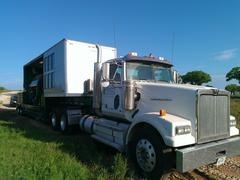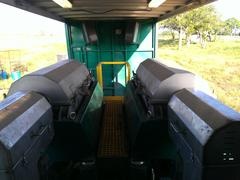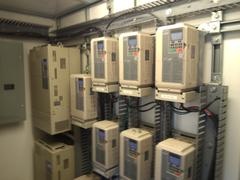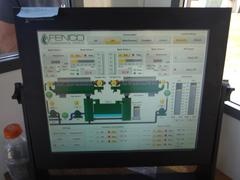Centrifuge Trailer Automation
Erdos Miller's work with GTech and Fenco to build a state of the art drilling mud filtering system mounted on an 18-wheeler trailer.

Traditionally, drilling mud is shipped off-site in large containers for filtering and reclamation. However, this can take quite a bit of time and the shipping costs are compounded per container. Fenco's plan is to bring the processing facility to the drilling mud containers at the rig site. They conceived an 18-wheeler trailer equipped with the centrifuge and other equipment required to do the job. They then contacted GTech HilTech to construct the trailers and Erdos Miller to design the software that would automate the entire process.

We started off by gathering the application requirements to determine what sort of processing power and I/O we needed. We then settled on one of the aptly powered cRIO modules from NI with a 4-slot chassis. With the addition of analog I/O, digital I/O and serial communications we were ready to start coding. We’re big fans of having flexible requirements for software because we know how hard it is to envision exactly what the software is going to be when it’s done. In our experience we’ve also seen applications like this quickly spiral out of control if you don’t lay the proper foundation. With this in mind, we began putting a framework in place. We developed a platform that allowed us to easily control variables from the HMI, communicate with an HMI, store variables persistently if necessary, and read configurations from a file. We used NI’s CVT Toolkit, network streams for communication, and the FPGA module for hardware I/O. We had plenty of hardware to interface to, including level meters, flow meters, VFDs, relays and valves.

We really enjoyed working with Yaskawa’s A1000 VFD drives, which were the primary VFD used on this project. We communicated with them both over serial and RS-485 and we were really impressed with their quality. If you’re interested in communicating with these drives with a cRIO or LabVIEW, give us a call.
With our platform in place we were able to quickly build out all of the automation that was already in our specifications. After final testing and integration into the prototype trailer, it was time to go to the field. The trailer spent a couple weeks in the field, and after the first few jobs were done, the crew had tons of feedback for improving the automation. It was impractical to bring the trailer back to Houston so we went to North Texas to continue working on the automation. Over a couple months the level of automation grew by orders of magnitude. We worked tirelessly at the customers facility and on-site at rigs to code and test automation. Today the trailers automation has expanded by orders of magnitude.

With the prototype trailer complete and field tested, the trailers have gone into production. The framework we built stood up under test, and even though the new trailer had significant differences in wiring and configuration, we were able to have the software adapt to it by only changing the values in our configuration files.If you need help with your automation project please don't hesitate to give us a call. We're happy to engage with you on any level whether that be writing code or simply giving a bit of advice.
Kenneth Miller
Erdos Miller
Co-Founder
LabVIEW Developer - CLD
Here's a video of the centrifuge trailer in action!

